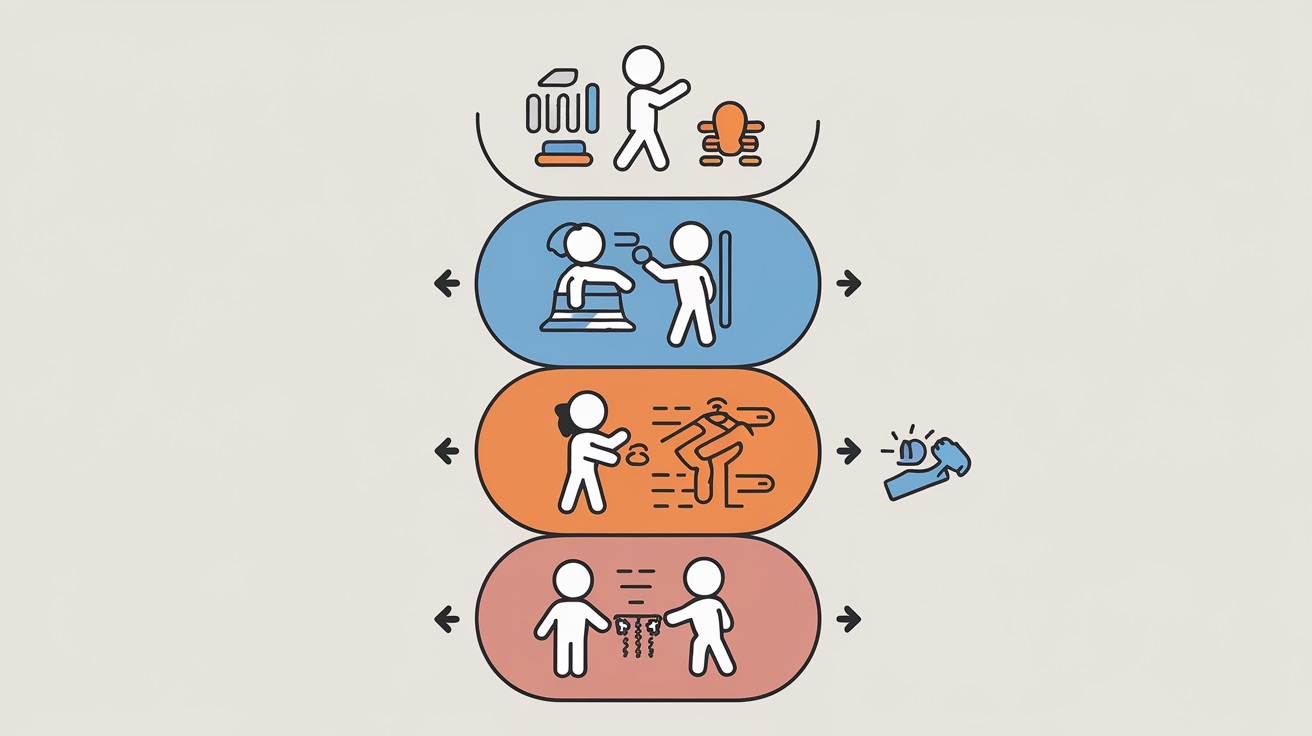
Workplaces are dynamic environments where employees continuously learn from one another. Albert Bandura's social learning theory explains how people learn by observing others, imitating behaviors, and experiencing outcomes. This theory has become increasingly relevant in organizational settings, where collaboration and skill development are essential for success.
In organizations, employees often model behaviors they see in peers or leaders. For example, a junior employee might emulate a senior colleague's approach to problem-solving after observing their success. This interaction creates a feedback loop, where positive reinforcement encourages further learning and behavior replication. Social learning theory integrates these natural human tendencies into actionable frameworks for improving organizational behavior, team collaboration, and leadership.
What is Social Learning Theory?
Albert Bandura's social learning theory provides a framework for understanding how individuals acquire knowledge and behaviors through observation, imitation, and reinforcement. These three core elements form the foundation of the theory:
Observation – Learning occurs by watching others, such as peers, mentors, or leaders, perform specific actions or solve problems.
Imitation – Individuals replicate the behaviors they observe, especially when those behaviors appear successful or beneficial.
Reinforcement – Outcomes, whether positive (rewards) or negative (consequences), influence the likelihood of repeating these behaviors.
Unlike traditional learning models, which depend heavily on direct instruction or individual experience, social learning theory emphasizes the social context of learning. It highlights how individuals do not operate in isolation but instead learn from interactions within their environment. Role models play an essential part in shaping behavior, whether intentional or incidental. For instance, observing a respected colleague's successful approach to problem-solving can inspire others to adopt similar strategies.
Additionally, the theory underscores the value of peer influence and shared experiences in enhancing learning outcomes. Through collaboration and observation, individuals acquire practical knowledge, adapt to group norms, and develop the skills to succeed in various settings. This makes social learning theory particularly applicable to workplaces, schools, and communities.

Relevance to Organisational Behaviour
Social learning theory plays an essential role in shaping organizational behavior, as it integrates individual learning into the broader context of team and leadership dynamics. In organizations, it drives key outcomes:
Skill Development:
Employees develop new abilities by observing experienced colleagues, learning practical techniques, and adapting them to their roles. This informal yet impactful method accelerates competency-building without relying solely on formal training.
Team Cohesion:
Shared learning experiences foster collaboration and understanding among team members. Employees create a more harmonious and productive team environment by observing and adapting to each other's work styles.
Leadership Development:
Leaders act as role models, setting behavioral standards through their actions. When leaders demonstrate positive traits such as empathy, problem-solving, or ethical decision-making, their teams naturally adopt these behaviors.
A new hire in an organization may quickly adapt to their role by observing colleagues' communication styles, workflow practices, and tool use. This process reduces onboarding time, enhances confidence, and integrates them seamlessly into the team. By learning through observation, employees align more effectively with organizational goals and foster a culture of continuous improvement.
Core Principles of Social Learning Theory
1. Observational Learning
Observational learning is central to social learning theory. Employees observe peers, leaders, or mentors to learn new behaviors and strategies.
A junior team member learns effective communication techniques by observing how a senior leader handles client meetings. These insights often translate into improved performance during future interactions.
2. Role of Reinforcement and Motivation
Reinforcement can be positive (rewarding desirable behaviors) or negative (discouraging unwanted actions). Motivation is key, as employees are likelier to emulate rewarding or impactful behaviors.
Studies show that employees who receive positive reinforcement for modeled behaviors are 30% more likely to replicate those actions consistently.
Applications of Social Learning Theory in the Workplace
1. Peer Learning and Collaboration
Social learning thrives in collaborative environments where employees share knowledge and experiences.
In cross-functional teams, members bring unique perspectives, encouraging mutual learning. For example, a marketing team member may learn technical skills from an IT colleague during a collaborative project. Organizations with collaborative learning frameworks experience a 25% increase in team productivity.
Leaders act as role models, setting examples through their actions and decisions. When leaders demonstrate desired behaviors, employees are more likely to emulate them.
At Tesla, Elon Musk's hands-on leadership style motivates engineers to adopt a proactive problem-solving mindset. This influence has directly impacted project success rates and team morale.
2. Corporate Training and Development
Incorporating social learning into corporate training programs enhances knowledge retention. Role-playing, group activities, and real-life scenarios make learning more engaging and effective.
Many companies use mentorship programs to support employee growth. These programs pair new hires with experienced professionals, facilitating peer-driven learning.
Benefits of Social Learning in Organisations
1. Enhanced Team Dynamics
Social learning strengthens team bonds by fostering trust and mutual understanding. Employees working closely often align better with shared goals.
2. Improved Employee Engagement and Retention
Interactive learning environments make employees feel valued and invested in their roles, leading to higher job satisfaction and lower turnover rates.
Employees in organizations prioritizing social learning report 15% higher engagement levels and a 20% increase in job satisfaction.
3. Fostering a Culture of Continuous Learning
Social learning encourages lifelong learning within organizations. Employees stay adaptable and open to acquiring new skills.
Organizations with continuous learning cultures experience 46% higher employee productivity than those relying on traditional methods.
Real-Life Examples and Case Studies
Google's Peer Learning Programs
Google emphasizes social learning through platforms like Google Workspace, enabling employees to share knowledge and collaborate in real-time. Peer collaboration has been a cornerstone of its innovation-driven culture.
IBM's Mentorship Initiatives
IBM's mentorship programs pair junior employees with senior mentors, promoting knowledge transfer and skill development. This approach has significantly boosted employee satisfaction and productivity.
IBM reported a 32% increase in employee retention rates following the implementation of their mentorship programs.
Step-by-Step Guide to Implementing Social Learning in Organisations
1. Establish a Mentorship Program
Create structured mentorship opportunities where experienced employees guide newcomers. This fosters mutual learning and professional growth.
2. Encourage Cross-Functional Collaboration
Organizations should promote interdepartmental projects to encourage diverse knowledge sharing.
A collaboration between marketing and IT teams can lead to innovative digital campaigns, combining creativity with technical expertise.
3. Leverage Technology
Tools like Slack, Zoom, and Microsoft Teams enable employees to collaborate and learn virtually. Learning management systems (LMS) can also facilitate structured social learning.
Challenges in Adopting Social Learning Theory
Resistance to Change
Some employees may need help adopting new learning methods, especially if they are typical of traditional approaches.
Balancing Individual and Team Goals
It isn't easy to balance personal growth and team objectives. Clear communication and goal alignment are essential.
Conclusion
Social learning theory offers a practical and effective approach to enhancing organizational behavior. Organizations can foster collaboration, leadership development, and continuous learning by leveraging observation, imitation, and reinforcement.
Leaders and HR professionals should prioritize integrating social learning frameworks to create a dynamic and adaptive workplace.
FAQs
What is social learning theory in organizational behavior?
Social learning theory offers how individuals learn by observing others' behaviors and replicating successful actions in a workplace context.
How can leaders use social learning theory to improve the workplace?
Leaders can set examples through their actions, encouraging employees to model their behaviors.
What are examples of social learning in organizations?
Examples include mentorship programs, peer-based training, and leadership modeling.
What are the challenges of implementing social learning theory?
Challenges include resistance to change and balancing individual learning with team goals.
How does technology enhance social learning?
Tools like Slack and Zoom enable real-time collaboration and virtual learning opportunities.
Social Learning Theory

